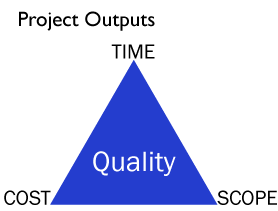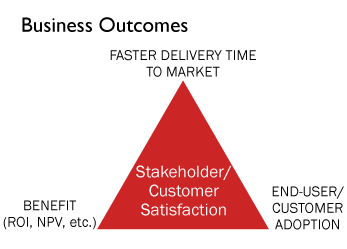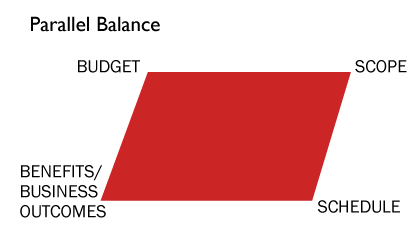

How Do You Measure Project Success? Rethinking the Triple Constraint
By Jack S. Duggal
 Do you find yourself trapped in the triple constraint?
Do you find yourself trapped in the triple constraint?
Project managers are expected to manage the triple constraint and are often compelled to live in this triangle of time, cost and scope/quality.
The initial idea of the triple constraint was a framework for project managers to evaluate and balance these competing demands. It became a way to track and monitor projects. Over time, it has also become a de facto method to define and measure project success.
While the triple constraint is necessary, it is not enough.
Projects that are delivered on time, within budget and meet scope specifications may not necessarily perceived to be successful by key stakeholders.
Besides time, cost, scope and quality, what are other criteria for project success in your organization? We asked this question of project stakeholders in a survey conducted by the Projectize Group in 2008-09. Participants identified these factors contributing to project success:
- Stakeholder and customer satisfaction;
- Meeting business case objectives;
- Customer/end-user adoption;
- Quality of delivery;
- Meeting governance criteria; and
- Benefits realization.
An important concept to understand is that time, cost and scope are related to project outputs, whereas the other factors are related to business outcomes.
While the triple constraint is important, it can also narrow the focus away from other crucial factors that lead to project success. Based on today’s project environments, project managers need to broaden their perspective to include other criteria to satisfy stakeholders and deliver business results.
In a recent workshop, we challenged a group of project managers and their managers to rethink and redesign the idea of the triple constraint to measure projects based on their experience at their organizations. The criteria were to help project managers focus and balance the right things that lead to project success.
The following are three perspectives that were presented as a part of the exercise.
1) Mirror project outputs with business outcomes – While focusing on each of the triple constraints, the project manager has to reflect and make project decisions based on the achievement of the corresponding business outcome. Cost and time focus has to optimize business benefits like ROI, NPV, etc., and benefits of faster delivery or time-to-market. Scope has to mirror end-user adoption, and overall quality has to be balanced with stakeholder/customer satisfaction.


2) Parallel balance – This is a parallelogram view of balancing between scope and schedule in parallel with budget and benefits, or budget and scope in parallel with schedule and benefits. Benefits may include a combination of business objectives; end-user adoption; customer satisfaction and other criteria.

3) From a triangle of constraints to a diamond of opportunity – The diamond combines the tactical focus of project outputs on one side with strategic outlook of business outcomes on the other. Also included is the effective use of and compliance with governance processes and quality of delivery. The idea of the multiple sides of the diamond also helps the project manager to include multiple perspectives of focus that might be relevant to their business.
For example, in many organizations a new criteria that is becoming a critical balancing factor similar to quality is health, safety, security and environment (HSSE).

If you are expected to focus on the triple constraint alone, expanding your focus to include additional criteria will give you an edge. You will be able to deliver projects that provide business benefits and your projects will be perceived to be successful by your stakeholders.
Do you have a model that you would like to share or provide feedback on any of the above approaches? In a future column we will revisit this topic and discuss a consolidated approach.
Mr. Duggal is the managing principal of Projectize Group LLC, specializing in next generation training, consulting and tools, and a PMI SeminarsWorld® leader of the seminar Building a Next Generation PMO and Portfolio Management. For questions on the content of the seminar, or your comments and feedback, please contact Mr. Duggal.


